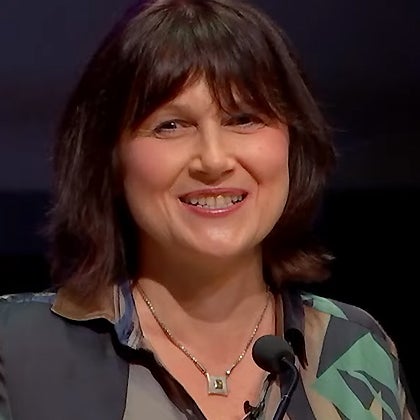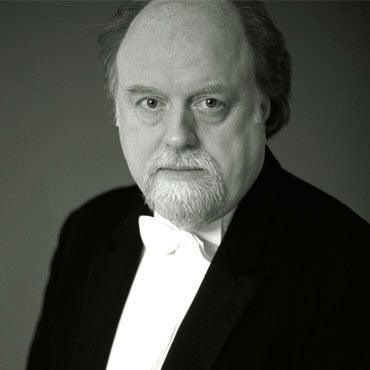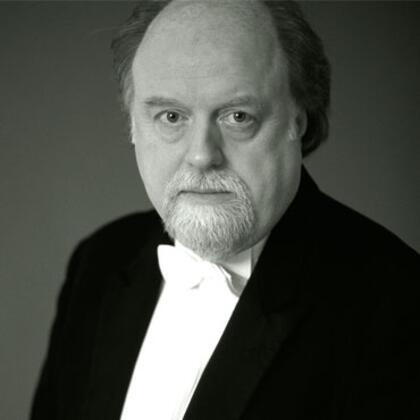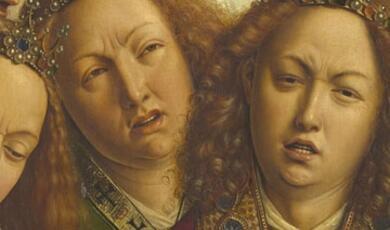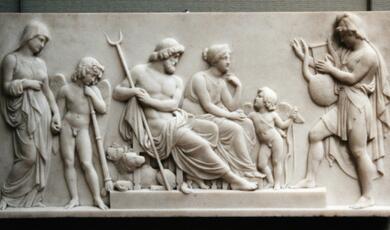Diminished and Augmented Chords
Share
- Details
- Text
- Audio
- Downloads
- Extra Reading
In this lecture, we will delve into the history of opera because that is where the diminished seventh-chord gradually accumulated its expressive power as a chord for dramatic climaxes, demonic intrusions and generally for shock and horror of any kind. The augmented triad came to be used for the mysterious and supernatural. The symmetrical structure of these two chords allowed composers to veer off into unexpected keys or create new scales which have not shed their strangeness, even today.
With Pianist Peter Donohoe CBE
Download Text
Diminished and Augmented Chords
Professor Marina Frolova-Walker
9th February 2023
We have been talking so far about how chords are used to create structure for phrases, sections and even whole pieces. Today we are going to look at chords that are quite dispensable as far as structure is concerned, but which contribute a special colour in each case. The striking sounds of these chords have allowed them to pick up meanings over time more readily than the chords that have structural roles to play.
The Diminished-7th Chord
We will turn first to the diminished-7th chord. Composers have noted its expressive properties. Schoenberg picked it out as a chord that was “expressive” in itself, while Alfredo Casella called it a chord of “astonishment”. We will begin with two examples, the first a terrifying orchestral hit from the soundtrack of King Kong; and the second a magical harp glissando from Liszt’s Mephisto Waltz (a kind of glissando that became so popular that it can now be downloaded from sound-effects libraries as a recognised expressive unit).
On each note of a major scale, we can build either a major or a minor triad, drawing on other notes from the same scale. But there is one exception: when we reach the seventh note of the scale, neither of these triads can be constructed, and instead, we have what is called a “diminished triad”. The root and 3rd of the chord are in the same relation as in any minor triad, but when we compare the root with the 5th, we find an interval that is a semitone narrower than normal. This is an unstable chord that cannot be used to finish a phrase. It is also impossible to for this kind of triad to become the centre of a key, since keys only come in major and minor varieties – there is no such thing as a “diminished key”. So far, each successive note is the same interval above the previous note, namely a minor 3rd; if we continue along these lines and add another note a minor 3rd above the top not of the triad, then we obtain a “diminished-7th chord”. If we try to invert it on the piano, nothing changes: each inversion still has successive notes at the same distance apart, so all the inversions give us the same sonority, only differing in being higher or lower. This results from a property of the chord that we haven’t encountered until now: it divides the octave into (four) equal parts. As a corollary, the chord is also symmetrical. The major and minor triads and dominant 7th chords that we have previously seen all lacked this symmetry, since they consisted of mixtures of different intervals.
The diminished-7th chord can be traced back to Italian opera of the late 17th century. The composer Giovanni Legrenzi was so bold as to begin one arietta on this chord-type, namely “Che fiero costume” from the opera Eteocle e Polinice (ca. 1680). The text is a bitter complaint directed at Cupid, who has made the protagonist suffer, and the opening diminished 7th chord conveys the tension of the scene perfectly. The following generations of composers agreed with Legrenzi that this was a chord of agitation, suffering and tears. In the operas of the early 18th century composer Johann Adolph Hasse, we find the chord in recitatives wherever the text suggests heightened emotions. For example, at the words “mia pietosa madre… o cara madre!” – my poor mother… o dear mother!, the second phrase is given a diminished 7th chord, or in “allora avrai findi Fabricio e pianti” (you will find Fabricio and weep), the idea of “weeping” is introduced by another diminished 7th chord.
This is striking enough, but straightforward and easy for the listener to grasp. In the music of Hasse’s contemporary, JS Bach, there is an explosion of diminished-7th chords used in unprecedented ways. Take, for example, his organ chorale prelude “Durch Adams Fall ist ganz verderbt / Menschlich Natur und Wesen” (Through Adam’s fall humanity’s nature and being was utterly corrupted). The pre-existing chorale tune is simple (heard in the top voice of the piece). Bach’s bass line, however, is quite extraordinary: three times, it falls by the interval of a diminished 7th (the gap between the outer notes of our chord) – the notion of The Fall is symbolised here. The middle voices respond by twisting and turning to form many diminished 7th chords, which Bach most likely intended to symbolise the snake. Any sense of a key is heavily obscured by the pervasive use of notes from outside the scale (which musician’s call “chromaticism”). To the first-time listener, it is so obscure and disjointed, that it will barely make sense (although there is a definite logic discernible through analysis or repeated listening). Bach could hardly have created a more apposite and disturbing image for the subject of the chorale text, and it is all the more remarkable that he fitted all the lower parts to the unremarkable chorale melody.
A very famous moment occurs in Bach’s monumental oratorio St Matthew Passion, at the point when Pontius Pilate asks the assembled crowd who is to be spared, Jesus or Barabbas? Dramatising the moment perfectly, Bach gives the chorus a diminished-7th chord when it yells back “Barabbas!”.
There is another extraordinary piece by JS Bach that uses the dim 7th in every conceivable way: his Chromatic Fantasia and Fugue for keyboard (the Fantasia section is our only concern here). So what are the different ways the chord is used here?
- As a more dissonant extension of the dominant 7th chord:
- Arpeggios (chord notes struck in turn) outlining several diminished-7th chords in a row, which erodes any sense of key:
- As a dramatic turning point, as in the following example, which gives way to a descent in rapid notes, all fitting the diminished-7th chord that has just been heard:
- With the further dissonance of a melodic note that doesn’t belong to the diminished-7th chord:
- Staying on the same diminished-7th chord for a long time, weaking the listener’s sense of the previously established key, which allows Bach to use this ambiguous chord to shift to another, distant key:
The diminished-7th chord, then, is pervasive in the fantasia, and it is used to create tension and drama, with a suggestion of tragedy, often resulting in tonal disorientation for the listener.
“Ombra” and “Tempesta”
Bach seems to have used up all the expressive and syntactic options for the diminished-7th chord, but fortunately for the following generations, his music fell into obscurity, allowing them to rediscover for themselves the potential of the chord. Scholars of late 18th-century music have noticed that the chord occurs most often in one of two expressive contexts, which they call “ombra” (shadow) and “tempesta” (storm). “Ombra” denotes the terrors of the supernatural. In William Boyce’s 1756 setting of an “Ode to Shakespeare”, there is a striking passage in the text:
When horror ombers o’er the scene
And terror, with distorted mien,
Erects the hair, and chills the blood…
prompting Boyce to use a prominent diminished-7th chord at the word “terror” (and continuing for the rest of the line). In the mid-18th century, artists began to explore “the sublime”, a category that embraced unsettling or even frightening experiences caused by powerful forces of nature, or, indeed, by the supernatural. Edmund Burke gave the subject a theoretical treatment in his influential essay of 1757, “On the Sublime and the Beautiful”, where he draws attention to “the sublime of terror”:
“Whatever is fitted in any sort to excite the ideas of pain, and danger, that is to say, whatever is in any sort terrible, or is conversant about terrible objects, or operates in a manner analogous to terror, is a source of the sublime; that is, it is productive of the strongest emotion which the mind is capable of feeling.”
A quarter of a century later, the Scottish poet and philosopher James Beattie wrote specifically about the ability of music to create this sublime of terror:
“Music is sublime when it inspires devotion, courage or other elevated affections: or when by its mellow and sonorous harmonies it overwhelms the mind with sweet astonishment: or when it infuses that pleasing horror… which, when joined to words descriptive of terrible ideas, it sometimes does very effectually.”
A perfect example of this “sublime of terror” is the apparition of the Statue in Mozart’s Don Giovanni. Mozart deploys several means to create his effect, including the insistent funereal rhythm and the addition of sombre trombones to his orchestra, but the diminished-7th chord is essential for creating the terror.
If we look at the “tempesta” context, we find a similar combination of devices, and once again the diminished-7th chord is very prominent here. A perfect example is the Storm movement from Beethoven’s Pastoral Symphony, where, together with frequent diminished-7th chords, we have, again, a minor key, orchestral tremolos, and timpani strokes.
Once a musical topic such as the “tempesta” has been established through opera, cantatas, or programme music, they can be identified in other pieces. The Storm movement began unexpectedly, without allowing the previous village-dance movement to conclude properly (as if the villagers were forced to scurry indoors). In Beethoven’s Appassionata Sonata, the interruption is still more extreme, with a calm, quiet slow movement that seems frozen in time at the end. A diminished-7th chord appears, mysterious and still quiet, but the same chord is then unleashed on the listener with full force, repeated insistently with nightmarish effect. Out of this terror pours a rapid stream of notes that will continue unabated for most of the movement. Beethoven was clearly pleased with the effect, although his powers of invention allowed him to present it in very different ways, and he managed to revivify it in his final piano sonata.
“Diabolus in musica”
The musical sublime of terror ran through the 19th century. One opera that made a lasting impression was Weber’s Freischütz (1821). Among other things, it introduced the concept of the leitmotif – a brief, easily recognisable piece of musical material that is associated with a particular character or prop on the operatic stage, allowing the composer to plant various associations in the minds of the audience. The character Samiel has an associated leitmotif that combines the sonority of the diminished-7th chord with string tremolos and timpani strokes – this much it holds in common with Mozart’s Statue, and likewise evokes the “ombra” category of terror. Later in the opera, Samiel is revealed to be the Devil himself. In the opera’s most famous scene, set in the “Wolf’s Glen”, we see the forging of magic bullets that will never miss their intended target, and in this creepy setting, the diminished-7th chord is used almost to saturation, imprinting itself on the minds of composers and listeners alike all across Europe. After this, there was a danger that the diminished-7th chord would sound clichéd in the hands of all but the most inventive composers.
Berlioz was one such composer, and in his Symphonie Fantastique (1830), the finale represents a witches’ Sabbath. The whole of the introduction is based on diminished-7th chords, moving from one to another without the need of resolution to a major or minor triad. As in Bach’s Chromatic Fantasia, Berlioz exploits the potential of the diminished-7th chord to undermine our sense of key uncertainty of key and to prolong our suspense. Berlioz still manages to wrench the diminished-7th chord and the ombra topic out of the dead grip of cliché.
And another celebrated concentration of diminished-7th chords is to be found in Meyerbeer’s opera Robert le diable (1831). One scene even unites the twin terrors of ombra and tempesta when a demonic apparition is accompanied by thunder and lightning, and Meyerbeer’s music rises to the occasion, with diminished-7th chords scored to frighten the audience pleasurably.
By this stage, the diminished-7th chord was taking on a more focused association with the infernal and diabolical. Let us extend this association to examine a very tenacious musical urban myth about a dissonance known as “diabolus in musica” (the devil in music).
If we start on any note of a diminished-7th chord, skip one chord-note and play the chord note after that, we have precisely the interval that is called “diabolical”. The myth grew up around a mnemonic verse for singers: “mi contra fa – diabolus in musica”. Skipping over details that are not relevant for our discussion, the mnemonic alludes to the most likely circumstance in which singers will sharpen or flatten notes in a way that makes sense for their own melodic line, but which will clash with the melodic line of another singer. When such clashes arose in rehearsal, a sign was penned into the notated music to prevent the same mishap from occurring in performance (which would often be during a mass). The problem cannot occur with modern notation, but depends entirely upon the notation of the 1300s-1500s, together with the conceptual framework that singers used to sing at sight from notation. The “mi contra fa” part of the verse points to a problem that would most commonly result in the supposed diabolical interval, but less frequently would be the clash between two notes with the same letter name, but different inflections, such as F natural heard at the same time as F# in a different voice (there were other possibilities, but these were statistically unlikely). The interval created by the more common clash was called a “tritone” – a term that belongs, etymologically, to medieval rather than modern music theory, but which has been preserved because of the “diabolus in musica” myth.
Singers of that period would have been well aware of the “mi contra fa” problem, but whether they thought of it (even jokingly) as the “diabolus in musica” is another matter. The mnemonic can only be traced back as far as 1725, to the writings of the music theorist J.J. Fux, although he tells us that its origins lay in the distant past. It was only in 1739 that the theorist Johann Mattheson applied the verse to the tritone only: “older singers … called this pleasant interval… ‘the devil in music’ ”. Even then, it took the best part of a century before this notion surfaced in the music of Weber, Meyerbeer, Berlioz, and Liszt. In their music alluding to the demonic and devilish, the tritone is used prominently, together with the related diminished-7th chord, which can be interpreted as two interlocking tritones.
Liszt’s Demonism
Liszt’s engagement with the demonic begins in his fantasy on Meyerbeer’s opera Robert le diable, in which he gives special prominence to the diminished-7th chord by placing it at the beginning of the piece. Later, he wrote a series of works inspired by the Faust legend: two piano pieces based on scenes from Faust, four Mephisto Waltzes for piano, and his two crowning achievements: the B-minor Piano Sonata and the Faust Symphony.
Liszt represents Mephistopheles as a virtuosic and charismatic musician, extending the mythology associated with Paganini and the supposed demonic source of his gifts. Although Liszt far outstripped Paganini as a composer, he regarded Paganini as a major influence for his cultivation of the most extreme virtuosity and the surrounding mystique of his image as a public performer. While Liszt’s virtuosity was due to his own assiduous work, he was happy to find that some of Paganini’s public image rubbed off on him too. In the words of those who knew him:
“And now the demon’s power began to awake; he first toyed with the public, as if to test it, then gave it something more profound, until every single listener was drawn up into his art; and then the entire mass of the audience began to rise and fall exactly in accordance with his will. With the exception of Paganini, I have never encountered any artist who possessed to such a high degree Liszt’s powers of subjugating, elevating, and leading the public.”
– Robert Schumann, 1840
“He played, as always, with a truly demonic bravura. He lorded it over the piano, like a devil (I know no other way to express it).”
– Clara Schumann, 1851
In every one of these works we find many fascinating harmonic innovations, often connected to the diminished-7th chord and its ability to resolve into distant keys. Liszt brilliantly ambiguates and undermines tonality by means of the diminished-7th chord in his B-minor Sonata in the passages that represent Mephistopheles, who can only distort and destroy (although how engagingly he does so in Liszt’s music!). Opposed to this music of Mephistopheles is a kind of musical and mythical opposite: a hymn-tune, suffused with nobility and grandeur, and hints of Christian suffering. To reduce this opposition to its starkest terms, we have chromaticism (with the diminished-7th chord) representing Hell, and diatonicism representing Heaven. The struggle continues throughout the Sonata, and although the very ending sounds heavenly rather than hellish, there is no sense of triumph, and the struggle seems unresolved.
More overtly, we hear this connection in Liszt’s Faust Symphony, which was completed four years after the Sonata. The three movements are entitled, “Faust”, “Gretchen” and “Mephistopheles”, although there is a substantial coda to the third movement that depicts the ascent of Gretchen’s soul to heaven. It is in the Mephistopheles section, of course, that we hear pervasive use of diminished-7th chords. Since Mephistopheles has duped and controlled Faust, the third movement also features mocking distortions of Faust’s themes from the first movement, amidst diabolical laughter (the closest precedent is the cackling of Berlioz’s witches in the Symphonie fantastique).
The Augmented Triad
This chord emerged later than the diminished-7th chord. Jean-Philippe Rameau recognised the augmented triad in 1722 as a possible formation on Note 3 of a minor scale (he referred to it as “accord de la quinte superfluë” – roughly “the chord of the augmented 5th). He included it, though, for the sake of theoretical completeness rather than as a recommendation for use in composition. Various later theorists also had doubts about its practical potential: Johann David Heinichen, in 1728, referred to it as a chord of “extraordinary hardness”; Kirnberger, in 1776, concluded that because of its dissonant sonority, the augmented triad was “quite useless”. But there was at least one dissenting voice: Georg Andreas Sorge classed it as a consonant triad, although he conceded that it was a particularly “sharp musical spice” (1747). Interestingly, he suggested that it could be used effectively to express death, suffering, and also doubt.
Passing from theorists to composers, we find that Haydn, in the third quarter of the 18th century, was able to absorb the chord into his normal style. In some places, it passes fleetingly and even routinely without making any special impression on the listener. But Haydn was, of course, aware of its expressive potential, and he brought this out in an agonised passage in one of his string quartets, all the more striking for its unexpectedness (the “Trio” middle section of the minuet movement in his Quartet op. 54 no. 2). He uses the augmented triad, repeats it, and then moves on in a related passage that substitutes a diminished-7th chord, as if he took the chord that was one level down in the scale of painfulness. He ends the section with a return to the augmented triad. In 1790, the theorist Albrechtsberger caught up with musical practice and laid out systematically the possible occasions for augmented triads.
Even so, the prominent theorist A.B. Marx still had misgivings about the chord as late as 1850:
“If we [take] the major triad and raise the fifth, we are confronted by the shrill sound of the augmented triad. No-one has ever dared to use several of these triads in succession, and we should do nothing to encourage this.”
Only three years later, however, Liszt did exactly that in his piano piece Pensée des morts (1853) – note the theme of death again. The music comes to a halt on a loud augmented chord, and then launches into a rapid passage that extends the chord by means of a long series of augmented triads rising by semitones. A.B. Marx and Liszt would have agreed, at least, that the passage was very harsh; they would only have disagreed on whether it should have been written at all. Liszt was fully aware of his pioneering role in the use of augmented triads:
“The augmented triad was still something remarkable at the time. Wagner had used these chords for the Venusberg [Tannhäuser], around 1845, but I had written them for the first time already in 1841…This brought much adverse criticism upon me... But I didn’t trouble over the matter.”
Liszt is referring back to a setting he made of Petrarch’s Sonnet No. 104 in the early 1840s. The augmented triad appears for one bar (a few seconds), but it is prominent, and is part of a progression (not just a decoration of some underlying major triad). Petrarch’s sonnet speaks of the turmoil love causes:
“I find no peace, but have no war to wage.
I fear, I hope, I burn and turn to ice.”
You will recall that a hundred years earlier, one of our theorists had speculated that the augmented triad might be used to express doubt. The time for that has come. Liszt worked on his Faust Symphony during the mid-1850s, and his first movement opens with a depiction of Faust in his study, puzzling over his books, uncertain of his future and whether he should resort to magic. Liszt presents Faust’s doubts and uncertainty with a strange, ponderous melody that spreads out the notes of an augmented triad, then another, a semitone lower, then two more, following the same pattern, with only some variation in the rhythm. This is not death, or suffering, but it is the perfect musical representation of doubt. The four successive augmented triads also run through all twelve notes of the chromatic scale and prevent any sense of key from emerging as yet. Liszt, as it happens, was anticipating the main compositional tool for writing music without a key – “atonal” music, as it came to be called. Sixty years after Liszt’s Symphony, Schoenberg began using patterned arrays of all the twelve notes. Liszt, too, as we shall see in a moment, took up an interest in the possibility of atonal music.
Like the diminished-7th chord, the augmented triad has the power to suspend tonality. It was perhaps for this reason Liszt used it in his depiction of a funeral gondola in Venice, the body floating over the lagoon to its place of rest. This is a haunting piece full of the adventurous harmonies Liszt was exploring in his later years. In this period, he even gave one of his pieces the explicit title Bagatelle sans tonalité. Any extract from the piece will sound perfectly Lisztian, as he plays with diminished, augmented and other chords, but anyone following the piece to the end will realise that it never establishes a key. It is worth mentioning that Liszt originally designated the piece as his Mephisto Waltz No. 4, so the demonic topic extends to this piece too. There are some remarkable moments worth noting: the opening gesture of a bare tritone; the moment when a diminished-7th chord gives way to an augmented triad; a rapid cadenza, based on the notes of a diminished-7th chord with other notes filling in some of the gaps; the ending with a long succession of diminished-7th chords rising by a semitone. Liszt, as a cleric in minor orders, would have been well aware of the traditional Catholic philosophical view of evil as the absence of good, rather than as a force in its own right, hence the association of Mephistopheles with a piece that has been deprived of tonality. For this reason, it is unclear whether Liszt saw atonality as a path that music should take, or whether he regarded it as just a further episode in his musical exploration of the topic of evil.
The diminished-7th chord came to be associated with a new scale, known as the “octatonic”, since there are eight notes in the scale instead of the usual seven. Liszt made tentative use of this from the 1850s onwards, but it emerges more confidently in the music of Rimsky-Korsakov, who passed it on to his pupil Stravinsky, who then influenced younger modernists. The augmented triad also has an associated scale, known as the whole-tone scale, since each step is a tone – there are no semitones – and this also means that there are only six notes in the scale. The strangeness of such a scale lent it to representations of the supernatural. The pioneer, in this case, was the Russian composer Mikhail Glinka, who referred to the new scale as ”chemical” (i.e. the product of a laboratory rather than of nature), and he put it to use very effectively to characterise the evil sorcerer Chernomor in his opera Ruslan and Liudmila. Musorgsky, in the next generation of Russian composers, represented Boris Godunov’s nightmarish visions with augmented triads and other whole-tone scale sonorities.
As an admirer of Musorgsky, Debussy explored the scale further, and in the end, made such memorable use of it that it became associated with him above all. In his piano prelude Voiles (Sails, or possibly Veils), he creates an atmosphere of mystery by using whole-tone scales and augmented triads, contrasting it with sections that are simpler and more tuneful (these use a five-note scale common in folk music the world over). This prelude has been connected by some scholars to Debussy’s interest in the occult practices, which were very much in vogue then. In Debussy’s piano piece L’Isle Joyeuse, there is a similar contrast. At the beginning, there is a cadenza-like passage consisting of augmented triads, and other sections make use of related whole-tone scale sonorities, creating a sense of dizziness and intoxication (there is nothing more sinister). Between these passages, there is more straightforwardly tonal material in major keys, with jubilant fanfares, especially towards the end. The piece is longer and more virtuosic than the prelude, and Debussy hints at the rhythm of the Habanera dance to draw together the contrasting musical material.
© Professor Frolova-Walker 2023
References and Further Reading
R. Larry Todd, “The “Unwelcome Guest” Regaled: Franz Liszt and the Augmented Triad”, 19th-Century Music, Vol. 12, No. 2, Special Liszt Issue (Autumn, 1988), pp. 93-115
Casella, Alfredo, and Theodore Baker. “Tone-Problems of To-Day.” The Musical Quarterly 10, no. 2 (1924): 159–71
McClelland, Clive, 'Ombra and Tempesta', in Danuta Mirka (ed.), The Oxford Handbook of Topic Theory, Oxford Handbooks (2014)
David Carson Berry, The Meaning(s) of “Without”: An Exploration of Liszt’s Bagatelle ohne Tonart, 19th-Century Music, 27 (3 ), 230
The Great Myth of the Medieval Tritone Ban (Adam Neely) https://www.youtube.com/watch?v=3MhwGnq4N9o
Aubrey S. Garlington, Jr. “Le Merveiileux” and Operatic Reform in 18th-Century French Opera, The Musical Quarterly, Oct., 1963, Vol. 49, No. 4 (Oct., 1963), pp. 484-497
Raymond Monelle, Opera Seria as Drama: The Musical Dramas of Hasse and Metastasio (1987 PhD thesis).
Alexander Rehding, “Rousseau, Rameau, and Enharmonic Furies in the French Enlightenment”, Journal of Music Theory, Spring, 2005, Vol. 49, No. 1 (Spring, 2005), pp. 141-180
References and Further Reading
R. Larry Todd, “The “Unwelcome Guest” Regaled: Franz Liszt and the Augmented Triad”, 19th-Century Music, Vol. 12, No. 2, Special Liszt Issue (Autumn, 1988), pp. 93-115
Casella, Alfredo, and Theodore Baker. “Tone-Problems of To-Day.” The Musical Quarterly 10, no. 2 (1924): 159–71
McClelland, Clive, 'Ombra and Tempesta', in Danuta Mirka (ed.), The Oxford Handbook of Topic Theory, Oxford Handbooks (2014)
David Carson Berry, The Meaning(s) of “Without”: An Exploration of Liszt’s Bagatelle ohne Tonart, 19th-Century Music, 27 (3 ), 230
The Great Myth of the Medieval Tritone Ban (Adam Neely) https://www.youtube.com/watch?v=3MhwGnq4N9o
Aubrey S. Garlington, Jr. “Le Merveiileux” and Operatic Reform in 18th-Century French Opera, The Musical Quarterly, Oct., 1963, Vol. 49, No. 4 (Oct., 1963), pp. 484-497
Raymond Monelle, Opera Seria as Drama: The Musical Dramas of Hasse and Metastasio (1987 PhD thesis).
Alexander Rehding, “Rousseau, Rameau, and Enharmonic Furies in the French Enlightenment”, Journal of Music Theory, Spring, 2005, Vol. 49, No. 1 (Spring, 2005), pp. 141-180
Part of:
This event was on Thu, 09 Feb 2023
Support Gresham
Gresham College has offered an outstanding education to the public free of charge for over 400 years. Today, Gresham College plays an important role in fostering a love of learning and a greater understanding of ourselves and the world around us. Your donation will help to widen our reach and to broaden our audience, allowing more people to benefit from a high-quality education from some of the brightest minds.


 Login
Login
